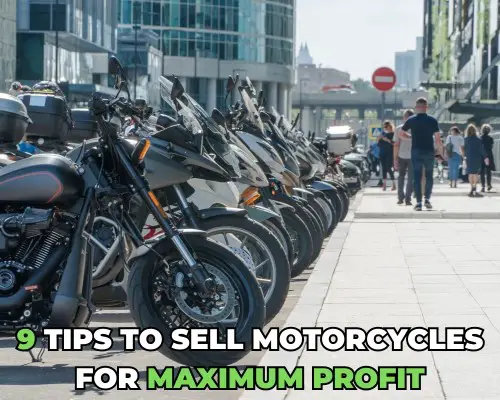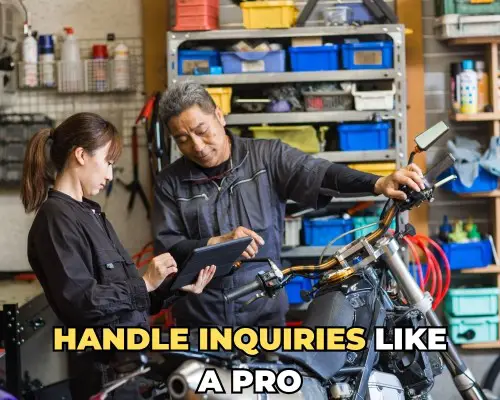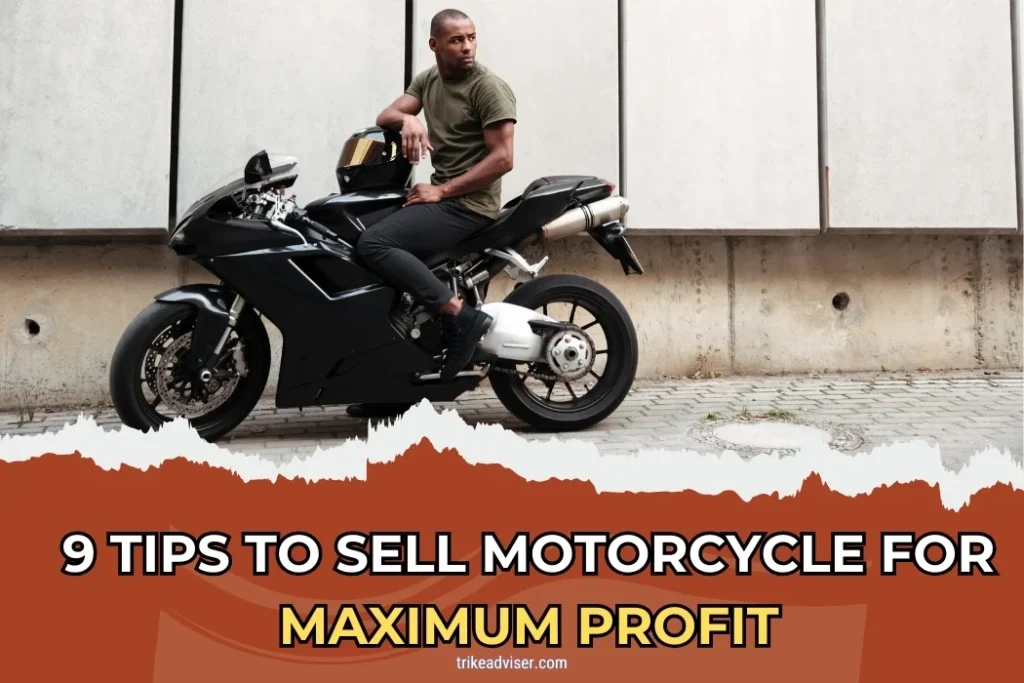Are you considering selling your motorcycle? It’s not just about slapping a price on it. No, it’s an art. You aim to maximize profit, but how? Sure, you want to sell it fast, but at what cost?
Many sellers struggle with this balance. It’s a typical predicament. If you set the price too high, customers will leave.
Too low? You’re passing up financial opportunities. Isn’t that annoying? Here, you’re not the only one. Every motorcycle seller faces this at some point.
Fear not, though. I have tips that streamline this process. They ensure you don’t just sell, but sell smart. Get ready to turn your motorcycle into cash effectively.
9 Tips to Sell Motorcycle for Maximum Profit

Price It Right
Did you know that setting the right price is like striking gold? Research the market value of your motorcycle by checking online ads, classifieds, and local dealerships.
Be realistic about the condition of your bike. A well-maintained 2010 model could fetch significantly more than one left in the garage to gather dust.
Set a competitive price that reflects its true worth. Just like weighing a duffle before a flight, getting this right means no nasty surprises later!
Sell It Fast
Want to sell your motorcycle yesterday? Utilize various methods to speed up the sale. Consider the local scene—maybe a sign on your bike parked on a busy street?
Or, tap into broader networks by selling to a dealer or listing on popular motorcycle marketplaces. Each method has its charm, and the right one depends on how quickly you need the cash.
Prepare the Paperwork
Imagine you’re buying, not selling. Wouldn’t you want everything clear and legal? Gather all necessary documents early—the title, service history records, and a bill of sale.
This not only makes the selling process smoother but also transparent, building trust instantly with potential buyers. It’s like having all your travel documents ready before heading to the airport.
Disclose Any Damage or Issues
Ever bought something that wasn’t quite, right? Avoid giving your buyers that feeling. Be upfront about any known defects or cosmetic issues.
This honesty protects you legally and helps the buyer make an informed decision. Think of it as marking fragile on a package—it ensures careful handling and proper expectations.
Consider a Motorcycle Auction
Is your ride something special? A rare, vintage, or particularly valuable motorcycle might benefit from the excitement of an auction.
This can often yield a higher sales price due to competitive bidding. It’s like that auction scene in movies—exciting, unpredictable, and potentially very rewarding!
Sell Online
Increase your reach by listing your motorcycle online. This broadens your pool of potential buyers, crossing local boundaries and possibly fetching a better price.
However, beware of scammers. Always verify buyer credibility and consider the logistics of motorcycle shipping, much like securing your valuables in a digital vault.
Negotiate Wisely
Negotiating can feel like a tense game of poker. Know the market value and be prepared to compromise to close the sale.
Effective negotiation is about balance—push too hard, and the deal might crumble; yield too much, and you might regret it. The goal? A handshake that leaves both parties smiling.
Choose the Right Buyer
Selecting who you sell to can be as important as the sale itself. opt for a reputable dealership or a private buyer with a solid reputation.
This ensures a smoother transaction and fair pricing, much like choosing a good travel partner ensures a smooth journey.
Stay Informed
The market shifts faster than the seasons. Keep up-to-date with motorcycle trends, economic shifts, and technological advancements that may affect bike values.
This knowledge isn’t just power—it’s profitable, helping you price your bike competitively and decide the best time and place to sell.
Just like a seasoned traveler who knows the best times to fly, being informed can make your selling experience much smoother and more rewarding.
Understanding Market Trends

Grasping market trends is like reading a roadmap before a long ride—it guides you to your destination efficiently and profitably.
Let’s delve deeper into how you can navigate these trends to sell your motorcycle at the best possible time and price.
Analyze Current Demand
- Market Cycles: Consider the ebb and flow of motorcycle demand, which peaks as the weather warms.
Like planning a road trip for sunny days, timing your sale in these peak months maximizes exposure and buyer interest.
Conversely, winter can freeze not just the ground but sales too, with a slump of 30-40%. This is when dealers fight the cold with hot deals, making private sales tougher.
- Electric Surge: The electric motorcycle market isn’t just growing; it’s exploding, projected to hit $40 billion by 2026.
Selling an electric model? Highlighting its eco-friendly features and low running costs can be just as attractive as its sleek design.
Seasonal Influences
- Strategic Timing: Much like a well-timed gear shift, knowing when to sell can turbocharge your results. Events like ‘Bike Week’ can rev up interest and prices, as enthusiasts swarm to make purchases.
Listing your bike during these events can be like dropping a fishing line in a well-stocked pond—bites are almost guaranteed.
- Regional Hotspots: In places like the EU, where electric bikes are gaining traction, or the US, where off-roaders are climbing in popularity, tailoring your sale to these hot markets can mean selling not just at a higher price but faster too.
Emerging Market Trends
- Ahead of the Tech Curve: Stay ahead by keeping an eye on technological advancements. Bikes equipped with the latest tech can attract a premium—much like how the latest smartphone models do at release.
Whether it’s cutting-edge safety features or breakthroughs in performance, these can be your selling points.
- Shift in Preferences: As the wind changes direction, so do consumer preferences. With a growing emphasis on sustainability, bikes that promise lower emissions or renewable energy usage are becoming the stars of the showroom.
Positioning your bike not just as a vehicle but as a choice for a greener future can resonate deeply with today’s buyers.
Understanding these market dynamics is not just about getting the best price—it’s about making an informed, strategic decision on when and how to sell your motorcycle.
Just like a skilled surfer who knows the best time to ride the waves, mastering these market trends can lead to a swift and profitable sale.
Handle Inquiries Like a Pro – Simple Techniques for Success

Handling questions from prospective customers is similar to preparing for a major journey: you need the appropriate equipment and mindset.
Here are some tips to make sure you’re screening and communication procedures function as smoothly as a well-oiled machine.
Communication Skills
- Be Clear and Concise: Think of each inquiry as a pit stop in a race. Time matters. Provide all necessary details about your motorcycle’s condition, features, and pricing swiftly and clearly.
It’s like packing your saddlebags; everything essential must fit and be easy to access.
- Responsive Engagement: Quick responses can make or break a deal. Imagine you’re on the starting line, waiting for the flag to drop; that’s how your buyer feels waiting for your response. Speed and precision show professionalism and respect for the buyer’s time.
- Address Concerns Proactively: If a buyer hesitates, dive into the details like a mechanic tuning an engine.
Explain how you’ve maintained the bike or upgraded parts. This builds trust and can accelerate the decision-making process.
Screening Potential Buyers
- Verification Checks: Just as a race official checks qualifications, verify your buyers. Ask for identification or proof of financing to filter out those who aren’t serious—like separating casual riders from real competitors.
- Qualification Questions: Tailor your questions to gauge buyer intent. Asking about their current bike or riding experience can reveal much about their seriousness and fit for your bike.
It’s a bit like checking the weather before a ride; it helps you prepare for what’s coming.
Active Listening
- Understand Buyer Needs: Active listening is key. It’s like tuning into the sound of your engine; you need to hear what’s working and what’s not.
Reflect on their words to ensure you’ve got it right, and adjust your pitch like you would your gears.
- Tailored Solutions: Once you catch what they need, respond by adjusting your route based on road conditions.
If they express concern about maintenance, reassure them with records or offer a recent service report.
Enhance Interaction Quality
- Ask Insightful Questions: Get to the heart of their concerns with thoughtful questions. It’s like using a precise map for a complex route.
This foresight can prevent roadblocks later in the negotiation process.
- Value Explanation: Clearly explain why your motorcycle is a prize worth paying for. Highlight its unique features, like a rare paint job or custom mods, which could be your bike’s equivalent of high-performance tires on a race track.
Build Relationships
- Engage Genuinely: Each buyer is a fellow rider on the road of life. Show genuine interest in their stories and needs.
This connection might lead them back to you for their next purchase or a recommendation to friends.
- Customer Loyalty: Good rapport can turn a buyer into a repeat customer. Just like a favorite biking route, they’ll come back for the familiarity and trust they feel with you.
Professional Development
- Communication Training: Even seasoned riders benefit from a new riding course. Similarly, enhancing your communication skills can sharpen your sales techniques and boost your confidence in handling diverse buyer personalities.
Mastering these techniques not only makes the sale more likely but also turns the experience into an enjoyable ride for both you and the buyer.
Just as you’d recount a memorable ride, handling inquiries well can turn into great selling stories.
Talk Your Way to Success – Negotiation Techniques

It may be both thrilling and intimidating to navigate the curves and turns of negotiation, much like when organizing a cross-country journey.
With these sophisticated tactics and professional advice, you can improve your negotiating skills and guarantee a smooth transition to a profitable sale.
Understand the Market
- In-Depth Market Analysis: Before you kick-start negotiations, conduct a thorough market analysis.
Understanding the price fluctuations and buyer demand across different seasons could help you time your sale perfectly.
For example, selling a sporty motorcycle might be more profitable in spring, right before the riding season peaks.
- Historical Sales Insights: Look at historical sales data if available. Knowing what similar motorcycles sold can give you a solid foundation for your price negotiations—like knowing you need your heavier jacket for a November ride across the mountains.
Anchoring and Framing
- Strategic Anchoring: Set an ambitious yet realistic anchor point. Think of it as setting your GPS with an extra half-hour buffer for traffic—it gives you a negotiation cushion.
- Positive Framing: Frame your motorcycle’s value beyond mere cost. Discuss its reliability, the joy of riding it on open roads, or its superior handling in wet weather. This can shift the buyer’s focus from price to value.
Consider the Other Party’s Perspective
- Empathetic Engagement: Like a seasoned tour guide, tailor your approach by understanding the buyer’s perspective.
Are they looking for a daily commuter or a weekend adventure ride? Aligning your pitch to their lifestyle can make the offer more appealing.
- Negotiation Partnerships: Sometimes, negotiation feels less like a battle and more like forming a partnership. Aim for a deal that makes the buyer feel they’ve won something too.
Determine Your Walk-Away Point
- Clear Boundaries: Know your minimum acceptable offer before you start talking. It’s like knowing your fuel range on a long journey—you don’t want to run out unexpectedly.
- Flexibility Within Limits: While you have a walk-away point, offer other concessions such as flexibility in payment terms or including accessories. These can often clinch the deal without costing you much.
Leverage Your Team
- Utilize Expert Opinions: If unsure, consult others who have been through this rodeo before. A friend who knows bikes or a trusted mechanic can provide third-party validation of your asking price and bike’s condition, adding weight to your stance.
Seek Win-Win Solutions
- Creative Compromises: If price becomes a sticking point, think laterally. Offer add-ons like a free first service or a set of new tires to seal the deal. It shows goodwill and can be the tiebreaker.
Common Negotiating Mistakes: Pitfalls to Avoid
Lack of Preparation
- Be Over-Prepared: Think of negotiation as a test ride. You wouldn’t head out without checking the bike over first. Know every detail about your motorcycle, from service history to every tiny scratch.
Focusing on Price Alone
- Broaden the Horizon: Like planning a route that includes scenic spots along with the fastest path, incorporate aspects such as delivery options, warranty, and possible future service discounts.
Being Afraid to Offend
- Confidence is Key: It’s like handling a powerful bike—you need to do it with confidence. Your firmness can often lead to respect, and a more serious negotiation.
Trying to Win
- Collaborative Approach: Instead of trying to ‘win’ the negotiation, aim for a satisfying journey for both. It’s like riding in a group—everyone should enjoy the ride, not just reach the destination.
Giving an Ultimatum
- Avoid Corners: Don’t corner your buyers with ultimatums unless necessary. It’s like forcing a bike into a tight turn at high speed—risky and unnecessary.
As an Amazon Associate, I earn from qualifying purchases, at no additional cost to you. Read Our Affiliate Disclosure.

